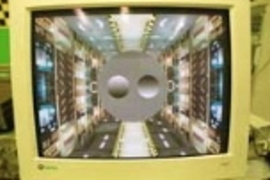MIT virtual-reality experiments planned for the International Space Station (ISS) could aid scientists' understanding of human balance disorders, with applications both for astronauts and people on Earth.
Last week, MIT's Center for Space Research (CSR) was awarded a $3.6 million NASA Johnson Space Center contract to develop and conduct these experiments and build the head-mounted virtual-reality display system for them. The team has already developed a prototype of this system.
The work could ultimately help astronauts prevent or recover from problems with movement control due to the lack of gravity. "It could also lead to new methods for evaluating motor disorders on Earth and for rehabilitative training," said Charles M. Oman, director of MIT's Man Vehicle Laboratory (MVL) and principal investigator for the international team involved in the work.
Dr. Oman also noted that the virtual-reality system itself "is intended as a generic facility, potentially capable of supporting on-orbit crew training (e.g., rehearsals of spacewalks) and robotic control activities."
On Earth, gravity provides a reference that influences how we recognize objects and perceive their shape and orientation. It also influences our expectations of how objects behave when thrown or dropped. The orientation of objects and surfaces in turn influences our own perceived orientation. Gravity also helps the central nervous system align the various frames of reference used in movement control.
"All these processes are fundamentally altered in weightlessness, as evidenced by the visual illusions frequently reported in orbit by astronauts, and also by the surprisingly long-lasting aftereffects seen, particularly after prolonged space flight," Dr. Oman said.
The new investigation, called VOILA (Visuomotor and Orientation Investigations in Long-Duration Astronauts), will use virtual-reality displays to study motion-related processes before, during and after long-duration flights. "ISS experiments will allow us to study human responses over three to five months in weightlessness, not just the one to two weeks afforded by a shuttle flight," Dr. Oman explained.
FIVE DIFFERENT TESTS
For VOILA, restrained and free-floating astronauts will wear a head-mounted virtual-reality display and view controlled visual scenes during five different tests. The tests will assess such things as the effect of perceived orientation on object recognition, and how catching objects is affected by gravity (and the lack of it). Two preflight, three inflight and three postflight performances of each test are planned on each ISS mission. The experiments are expected to begin in 2003.
VOILA merges and extends two investigations originally developed for the 1998 Neurolab space shuttle mission. The science team includes investigators from the United States, Canada, France and Italy.
In addition to Dr. Oman, other MIT participants are Dr. Andrew M. Liu and Elizabeth Zotos of the MVL and the CSR, and Laurence R. Young, the Apollo Program Professor of Astronautics. CSR engineers on the project led by Dr. William F. Mayer and Project Manager Richard F. Foster include Robert Goeke, Jim O'Connor, Mike Doucette and Matt Smith. Dr. Andrew C. Beall, who recently came here from the University of California at Santa Barbara, and Dr. Joseph P. McIntyre (PhD 1990), now on the neuroscience faculty at College de France in Paris, are also collaborating.
A version of this article appeared in MIT Tech Talk on November 8, 2000.








